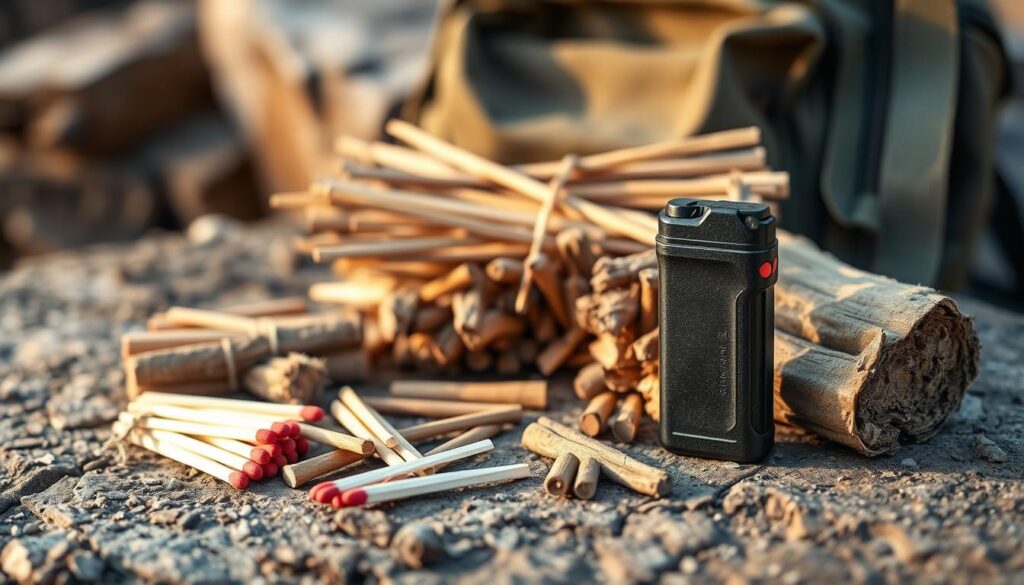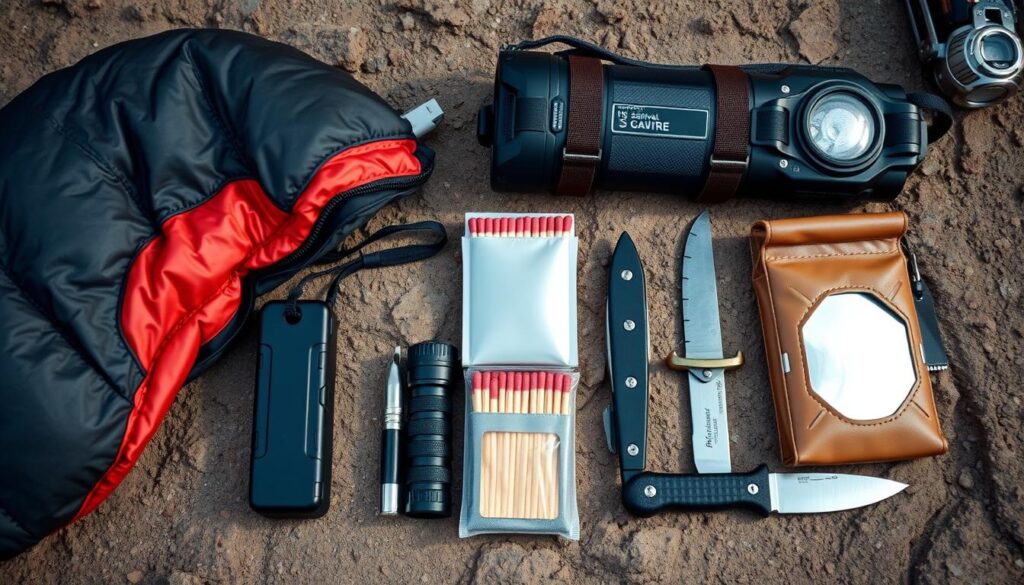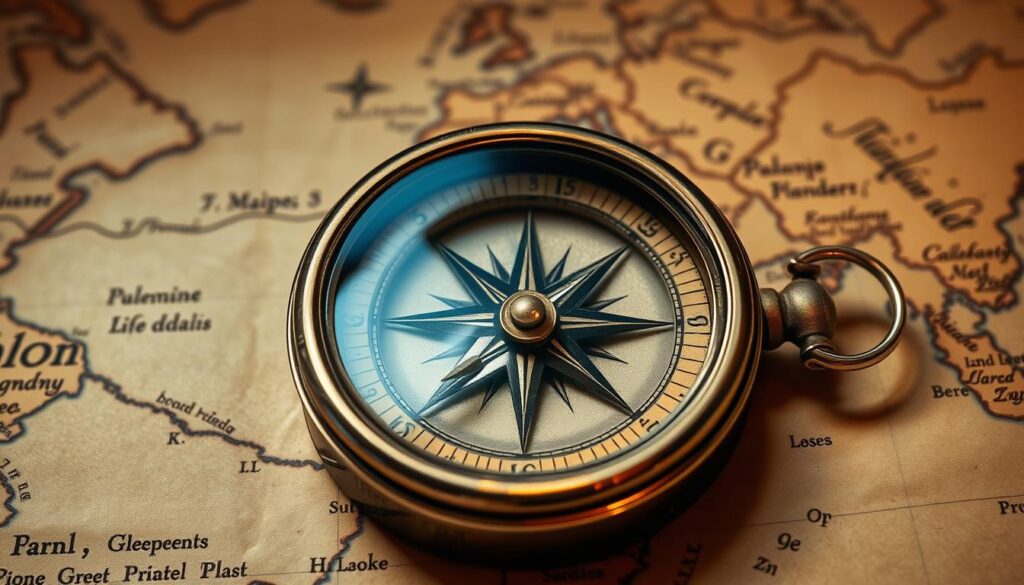I’ve spent many hours in the wilderness. I’ve learned that a reliable fire starter is key. It’s not just for warmth or cooking. It’s also for signaling for help, purifying water, or boosting morale.
Creating an emergency fire starter kit is vital for outdoor survival and emergency prep. You need a good fire starting tool, tinder, and kindling. In this guide, I’ll show you how to make a compact and effective kit.
A well-prepared compact fire starter is essential in survival situations. It’s about having the right tools and knowing how to use them until help arrives.
Key Takeaways
- Understand the importance of having an emergency fire starter kit for outdoor survival.
- Learn how to choose the right fire starting tool for your kit.
- Discover the best tinder and kindling materials for starting a fire.
- Assemble a compact fire starter kit that suits your needs.
- Gain confidence in your ability to start a fire in survival situations.
Why You Need an Emergency Fire Starter Kit
Fire is key in survival situations. It keeps you warm, lights your way, and cooks your food. This makes it essential for staying alive.
Understanding the Importance of Fire in Survival Situations
Fire is more than just a comfort; it’s a lifesaver. It offers warmth and comfort in cold weather. It also lights the surroundings when it’s dark. And, it cooks food safely for you to eat.
Fire can also signal for help when you’re in trouble. It’s a clear sign to rescuers. Plus, it helps purify water by boiling it, making it drinkable.
Common Scenarios Where a Fire Starter Kit is Essential
A fire starter kit is vital for many activities. It’s needed for camping, hiking, and emergencies. For example, during a power outage or disaster, it helps start a fire for warmth, light, and cooking.
| Scenario | Importance of Fire | Role of Fire Starter Kit |
|---|---|---|
| Camping | Provides warmth, light, and a means to cook food | Essential for starting campfires |
| Hiking | Offers warmth and light in case of an unexpected overnight stay | Crucial for starting a fire in wet or damp conditions |
| Emergency Situations | Serves as a signal for help and provides warmth | Provides a reliable means to start a fire |
In conclusion, an emergency fire starter kit is a must-have for survival. It ensures you can start a fire, which is vital for staying warm, finding your way, and calling for help.
Essential Components of a Fire Starter Kit
To make a good fire starter kit, you must know what it needs. A fire starter kit is key for survival, helping you start a fire for warmth, cooking, and signaling.
Fire Starters: Magazines, Tinder, and Other Options
A good fire starting tool is the heart of any kit. You can use matches, lighters, or tools like ferrocerium rods. You also need tinder and kindling.
Tinder, like dry leaves or small twigs, catches fire easily. Kindling, which are slightly bigger sticks, keeps the fire going.
There are also fire starter magazines that are waterproof and windproof. They help you start a fire in any weather.
Selecting the Right Matches or Lighters
Choosing the right matches or lighters is important. Look for ones that are tough and work well. Waterproof or storm matches are good for bad weather. A refillable and windproof lighter is best for outdoors.
Containers: Keeping Everything Dry and Ready
You need a container to keep everything dry and ready. Use a waterproof match case or a dry bag. It should be easy to open and close, even when it’s hard.
Choosing Fire-Starting Methods
It’s key to know about different ways to start a fire. This helps you get the most out of your fire starter kit. The right method depends on the situation and what tools you have.
Traditional vs. Modern Fire-Starting Techniques
Old-school ways include flint and steel, bow drill, and hand drill. These need practice but work well without modern tools.
Modern methods use lighters, waterproof matches, and ferrocerium rods. They’re quicker and easier but might not work in all situations.
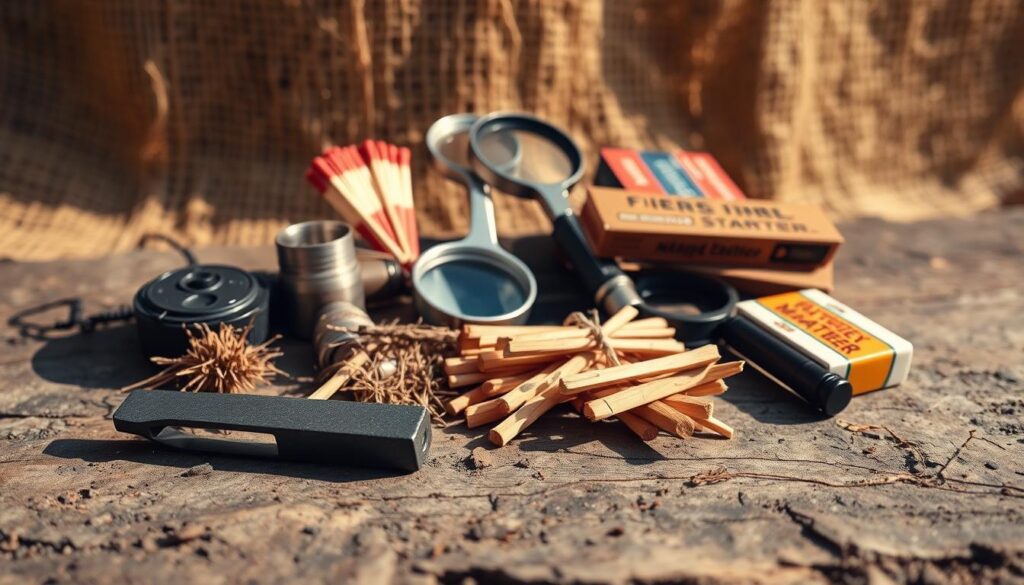
Best Practices for Using a Fire Starter Kit
Using a fire starter kit safely and effectively is important. Here are some tips:
- Keep your kit dry: Moisture can make many methods fail. Keep it in a waterproof bag.
- Practice regularly: Get to know different techniques. This helps you choose the best one for each situation.
- Choose the right tinder: Use dry, fluffy stuff like leaves, grass, or small twigs for tinder.
- Be mindful of your environment: In dry areas, be careful not to start a wildfire.
Knowing about fire-starting methods and following best practices makes your fire starter kit reliable. This is important when you really need it.
How to Assemble Your Fire Starter Kit
A fire starter kit is key for any emergency plan. Assembling it needs careful attention. You must include various parts to start fires in different situations.
Step-by-Step Guide to Building Your Kit
To make a complete fire starter kit, follow these steps:
- Choose different fire starters like waterproof matches, lighters, and ferrocerium rods.
- Add tinder like dry leaves, grass, and small twigs.
- Include kindling such as small sticks and branches.
- Find a good container to keep everything dry and organized.
Tip: Think about where you’ll use your kit most. For wet places, pick waterproof starters.
Organizing for Easy Access in Emergencies
After making your kit, organize it for quick use. Pick a waterproof, easy-to-reach container. You can use a plastic box or a waterproof bag.
By following these steps and organizing well, you’ll be ready to start fires when needed.
Tips for Storing Your Fire Starter Kit
Keeping your fire starter kit in good shape is key. It’s a lifesaver in emergencies. Here, we’ll talk about the best ways to store and keep your kit lasting longer.
The Best Locations for Fire Starter Kit Storage
Where you store your fire starter kit matters a lot. It should be in a dry, easy-to-reach place for emergencies. Think about putting it in:
- A bug-out bag or emergency kit
- A special survival kit spot in your home
- Your vehicle or other gear you use often
Make sure the spot is away from moisture and extreme heat. These can damage your kit.
Ensuring Longevity: Keeping Your Tools in Top Shape
Regular care is vital for your fire starter kit’s life. Here are some tips to keep it in great condition:
- Inspect your kit regularly: Look for wear, damage, or rust.
- Keep it dry: Wet tools won’t work.
- Replace items as needed: Swap out used items like matches and lighters.
- Store in a protective container: Use a waterproof one to protect against the elements.
By following these tips, your fire starter kit will stay ready for emergencies.
Testing Your Fire Starter Kit
Testing my fire starter kit is key to making sure it works when I need it. A fire starter kit must function well in emergencies. Regular testing ensures it’s reliable.
Importance of Regular Testing and Maintenance
Regular checks on my fire starter kit are important. I verify that the fire starters, like matches or lighters, work right. I also check that tinder or other materials are dry and ready to use.
This helps me spot any problems before a survival situation. Regular testing keeps the kit in good shape. For example, checking match expiration dates or lighter fuel levels prevents failures in emergencies.
It’s also key to look for damage or wear on the container. This keeps the kit safe and effective.
Safety Precautions During Kit Testing
When I test my fire starter kit, safety is a top priority. I choose a safe spot, away from flammable things or in a well-ventilated area. This prevents fume buildup from lighters or other fire starters.
Being aware of my surroundings is also critical. Keeping a fire extinguisher or a way to put out fires nearby is essential. This way, testing my kit doesn’t become a risk itself.
Upgrading and Personalizing Your Kit
As I work on my emergency fire starter kit, I see how key it is to upgrade and make it personal. It’s about knowing my surroundings, the emergencies I might face, and the best tools for those times.
Adding Unique Items That Reflect My Needs
To boost my fire starter kit, I think about adding special items that fit my needs and where I live. For example, if I’m often in wet places, I might add waterproof matches or a weather-resistant lighter. I also consider a ferrocerium rod, which makes sparks when scraped, for starting fires in different conditions.
- Ferrocerium rod for spark generation
- Waterproof matches for wet conditions
- Lighters designed for outdoor use
Balancing Weight and Usability in My Kit
When I personalize my kit, it’s important to keep it balanced. I aim for a kit that’s light and easy to carry, yet packed with vital tools for survival. This means choosing items that do more than one thing and focusing on the most important tools.
Key considerations include:
- Multi-use items that serve more than one purpose
- The weight and size of the kit
- Ease of access to critical components
By carefully upgrading and personalizing my fire starter kit, I make it more effective. It becomes a reliable tool in emergency situations.
Other Emergency Preparedness Tips
Preparing for emergencies means more than just having a fire starter kit. It’s about having the right tools, knowledge, and plans ready. This approach helps us stay safe in tough times.
Integrating My Fire Starter Kit with Other Survival Gear
Building a survival kit is about combining all essential tools. This includes a first aid kit, water purification tablets, and a reliable shelter. This way, we’re ready for any survival situation.
Creating a Comprehensive Emergency Plan
A good emergency plan is more than just gear. It needs a solid strategy with communication plans, evacuation routes, and emergency contact information. Adding my fire starter kit to this plan makes me ready for emergencies.
Keeping my emergency plan up to date is key. I should check it often and make sure everyone in my household knows the plan. This ensures we can all act quickly in an emergency.
Resources for Further Information
To better understand emergency preparedness, check out these resources. Being prepared is important, and having many sources of information helps. This way, you can stay informed and learn the best ways to handle emergencies.
Recommended Books, Videos, and Online Courses
There are great books on emergency preparedness that offer deep insights. For example, “The SAS Survival Handbook” by John ‘Lofty’ Wiseman and “When All Hell Breaks Loose” by Cody Lundin are top picks. If you like watching videos, Survival Life and Primitive Technology on YouTube are full of survival tips.
Online courses are also a good way to learn specific skills. You can find courses on first aid, wilderness survival, and building emergency shelters. Sites like Coursera and Udemy have these courses, taught by experts.
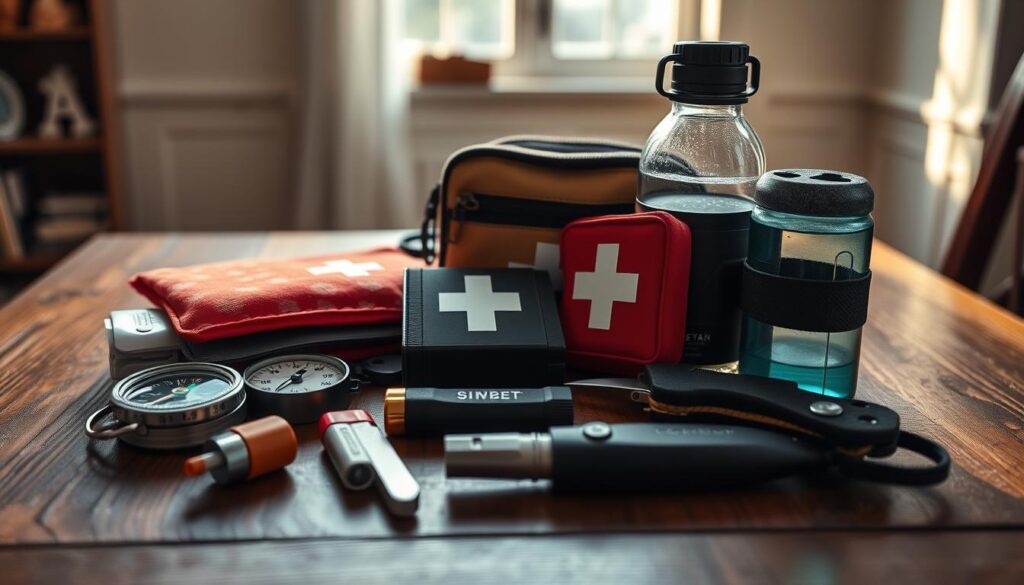
Community Resources: Local Workshops and Groups
Joining local workshops and groups is a great way to meet others who care about emergency preparedness. Many places have survival groups, outdoor clubs, or emergency preparedness organizations. They host workshops, training sessions, and meetings where you can learn and get hands-on experience.
To find local resources, search online for “emergency preparedness groups near me” or “survival workshops in [your city/state]”. You can also look at local community centers, outdoor gear stores, or online event calendars for events and gatherings.
| Resource Type | Examples | Benefits |
|---|---|---|
| Books | “The SAS Survival Handbook”, “When All Hell Breaks Loose” | In-depth knowledge on survival skills and emergency care |
| Videos | Survival Life, Primitive Technology on YouTube | Visual demonstrations of survival techniques |
| Online Courses | Coursera, Udemy | Structured learning on specific emergency preparedness topics |
| Local Workshops and Groups | Survival groups, outdoor clubs, emergency preparedness organizations | Hands-on experience, networking with like-minded individuals |
Reflecting on my outdoor adventures, I’ve learned the value of being ready for anything. A key part of this is having a dependable emergency fire starter kit. In this guide, I’ll show you how to create a kit that can start a fire in tough situations.
A compact fire starting tool is vital, as it can save your life in a survival situation. The right outdoor survival gear can turn a good camping trip into a safe one. I’ll share the must-have items for your kit and DIY fire starter recipes to keep you ready.
Key Takeaways
- Understand the importance of having an emergency fire starter kit for outdoor adventures.
- Learn how to choose the right fire starting tool for your kit.
- Discover DIY fire starter recipes for a reliable source of ignition.
- Identify the essential components of a compact fire starter kit.
- Understand how to use your outdoor survival gear effectively.
Why You Need an Emergency Fire Starter Kit
In survival situations, a reliable fire starter kit can be the difference between life and death. Fire is a vital tool, providing warmth, light, and a way to cook food. This increases your chances of survival.
It’s important to understand the role of fire in survival. Fire not only keeps you physically comfortable but also boosts your morale. It helps you stay positive during tough times.
Understanding the Importance of Fire in Survival Situations
Fire is essential in survival, with many benefits. It provides warmth, which is key in cold weather to avoid hypothermia. Fire also lets you cook food safely, making it more nutritious. Plus, it can be used to signal for help, attracting rescuers with its light or smoke.
“Fire is the best of companions; it is a pleasant thing even for the lonely.”
Fire’s importance is clear in survival, from lighting up the night to purifying water. Having a reliable fire starter is a must.
Common Scenarios Where a Fire Starter Kit is Essential
A fire starter kit is vital in many situations, including:
- Camping or hiking trips where electricity is scarce.
- Emergency situations like natural disasters or car troubles in remote areas.
- Survival situations where you need shelter and warmth.
Having a fire starter kit on hand can greatly improve your ability to handle these situations.
| Scenario | Importance of Fire Starter Kit |
|---|---|
| Camping/Hiking | Provides warmth, light, and a means to cook food. |
| Emergency Situations | Essential for signaling help and providing warmth. |
| Survival Situations | Critical for survival, providing warmth, light, and a way to cook food. |
As shown, a fire starter kit is more than a convenience. It’s a must-have in survival and outdoor scenarios.
Essential Components of a Fire Starter Kit
Knowing what’s in a fire starter kit is key. It’s a lifesaver in emergencies, giving you warmth, light, and a way to cook. A good kit is a must-have.
Fire Starters: Magazines, Tinder, and Other Options
The heart of a fire starter kit is a reliable fire starter. You can use matches, lighters, or ferrocerium rods. Matches work well but can get wet. Lighters are handy but might run out. Ferrocerium rods are tough and weather-proof.
Tinder and kindling are also vital. Tinder, like dry leaves or small twigs, lights easily. Kindling, like small sticks, helps grow the fire.
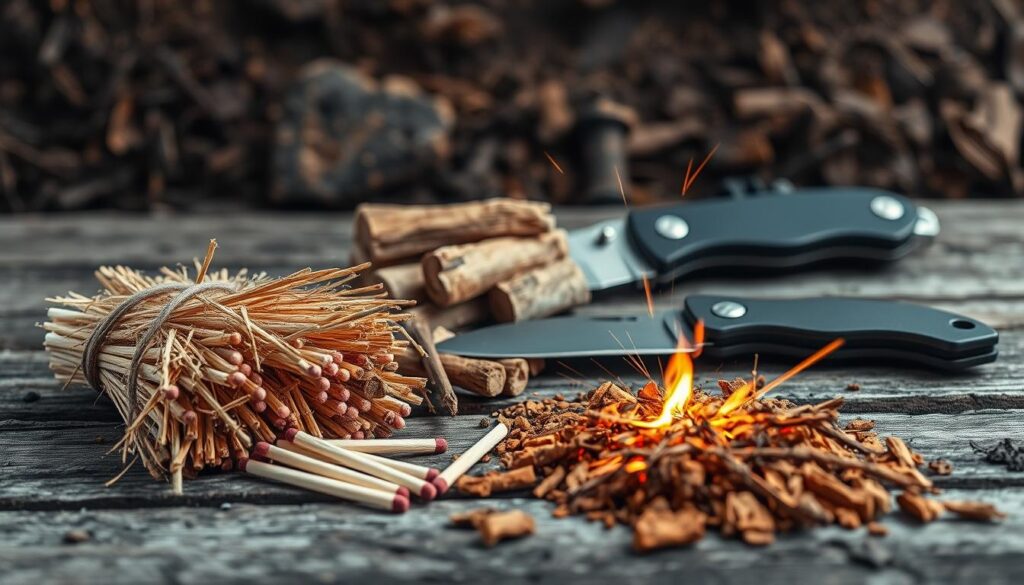
Selecting the Right Matches or Lighters
Think about where you’ll use your fire starter. Waterproof matches or a windproof lighter are best in wet or windy places. Having a backup, like a ferrocerium rod, is smart.
Containers: Keeping Everything Dry and Ready
A container keeps your kit dry and organized. Use a waterproof box or bag for your fire starter, tinder, and kindling. Keeping your kit dry is key, even in damp places.
| Component | Description | Importance Level |
|---|---|---|
| Fire Starting Tool | Matches, lighters, or ferrocerium rods | High |
| Tinder | Dry leaves, grass, or small twigs | High |
| Kindling | Small sticks | Medium |
| Container | Waterproof box or bag | High |
With these key parts, you can make a fire starter kit that’s ready for emergencies.
Choosing Fire-Starting Methods
Choosing how to start a fire is key in survival situations. The method depends on the situation and what tools you have. I’ll talk about traditional and modern ways to start a fire and how to use a fire starter kit well.
Traditional vs. Modern Fire-Starting Techniques
Traditional methods include flint and steel, bow drill, and matches. These have been used for ages and work today. Modern methods use lighters, ferrocerium rods, and other tools. Modern tools are often easier and more reliable, but knowing traditional methods is also important. They can be used when you don’t have modern tools.
Best Practices for Using a Fire Starter Kit
To use a fire starter kit well, follow some key steps. First, keep it in a dry place where you can easily find it. Second, practice using it often. Practicing helps you get better and spot any problems with the kit. Lastly, always be careful when starting a fire. Choose a safe spot and have a way to put out the fire if needed.
- Keep the fire starter kit in a dry and accessible location.
- Practice using the kit regularly.
- Follow safety precautions when starting a fire.
By following these tips and knowing about different fire-starting methods, I can make sure my fire starter kit works well in survival situations.
How to Assemble Your Fire Starter Kit
To be ready for emergencies, knowing how to put together a fire starter kit is key. It’s a simple task that needs some basic knowledge and the right stuff.
Step-by-Step Guide to Building Your Kit
Start by collecting all the parts you need, like fire starters, tinder, and containers. Pick a waterproof container to keep things dry.
Then, add your fire starters, such as matches, lighters, or ferrocerium rods. It’s smart to have more than one way to start a fire.
After that, add tinder like dryer lint, cotton balls, or small twigs. These help get your fire going fast.
Organizing for Easy Access in Emergencies
After you’ve put your kit together, organize it for quick access. Use small bags or compartments to keep things separate.
For example, put your fire starters in one bag and tinder in another. This makes it easy to find what you need when it counts.
Lastly, check your kit often to make sure everything works and your supplies are fresh.
Tips for Storing Your Fire Starter Kit
Keeping your fire starter kit in good shape is key. Choose the right spot and keep it in top condition. A well-stored kit can save your life in emergencies, helping you start a fire when it’s most needed.
The Best Locations for Fire Starter Kit Storage
Find a dry, easy-to-reach spot for your kit. Think about a bug-out bag, an emergency area, or a spot you can get to fast. Also, keep a small kit in your car or with your outdoor gear.
Ensuring Longevity: Keeping Your Tools in Top Shape
Regular checks are vital for your kit’s life. Look over your matches, lighters, and tools often. Swap out any damp or old items. Make sure tinder and other materials are dry. For tips on making an emergency fire kit, check out The Survival University.
| Storage Location | Benefits |
|---|---|
| Bug-out Bag | Easily accessible during evacuation |
| Designated Emergency Storage Area | Protected from the elements |
| Vehicle or Outdoor Gear | Portable and readily available |
Testing Your Fire Starter Kit
Testing my fire starter kit is key to making sure it works when I need it. A fire starter kit helps start fires, which is vital in survival situations. So, I test it often to keep it reliable.
It’s important to regularly test and maintain my fire starter kit. I check the fire starters, make sure the tinder is dry, and that the containers are waterproof and easy to get to.
Importance of Regular Testing and Maintenance
Testing regularly helps me spot any problems, like expired matches or a broken lighter. This way, I can fix or replace anything that’s not working right. It keeps my kit ready for emergencies.
To keep my kit in top shape, I store it in a dry, easy-to-reach spot. I also check the matches’ expiration dates, make sure the lighter is full, and keep the tinder dry.
Safety Precautions During Kit Testing
When I test my fire starter kit, I follow safety rules to avoid accidents. I do it in a place with good air flow, away from things that can catch fire. I’m also careful when I’m handling fire starters and fires.
To stay safe, I also know about local fire rules and follow them. This way, I can test my kit safely and effectively.
| Safety Precaution | Description |
|---|---|
| Test in a well-ventilated area | Avoids accumulation of smoke and fumes |
| Away from flammable materials | Reduces risk of accidental fires |
| Cautious handling of fire starters | Prevents burns and injuries |
Upgrading and Personalizing Your Kit
As I work on being better prepared for emergencies, I realize the importance of upgrading my fire starter kit. It’s about checking my kit, finding what needs improvement, and making it better for me.
When I think about improving my kit, I look at a few things. First, I check if my fire starters are waterproof and work well in different weather. I also check my tinder and kindling. Are they dry and work well in different places?
Adding Unique Items That Reflect My Needs
To make my kit my own, I add items that fit my needs. For example, if I’m often in wet places, I add waterproof matches or a ferrocerium rod. These are great in tough weather. I also add a compact lighter or a waterproof match case to keep my tools working well.
- Ferrocerium rod for spark generation
- Waterproof matches for reliability in wet conditions
- Compact lighter for ease of use
Balancing Weight and Usability in My Kit
It’s also key to balance the kit’s weight and how easy it is to use. Having a good kit is important, but it should also be easy to carry. I pick items that do more than one thing. This makes my kit useful without making it too heavy or big.
- Selecting multi-use items
- Optimizing kit utility
- Maintaining portability
By carefully upgrading and personalizing my fire starter kit, I make sure it’s a valuable part of my emergency plan. It’s tailored to my needs and situations.
Other Emergency Preparedness Tips
Building a fire starter kit is just the start. There are many other ways to prepare for emergencies. A good plan includes knowing how to respond, having the right tools, and knowing what to do.
Integrating My Fire Starter Kit with Other Survival Gear
It’s important to link your fire starter kit with other survival items. This means having a first aid kit, a way to clean water, and a place to stay. Together, these items make a strong plan for emergencies.
A first aid kit helps with injuries. A water filtration system gives you clean water. And a shelter keeps you safe from the weather.
| Survival Gear | Purpose |
|---|---|
| Fire Starter Kit | Starting fires for warmth, cooking, and signaling |
| First Aid Kit | Treating injuries and preventing infections |
| Water Filtration System | Providing access to clean drinking water |
| Shelter | Protecting from the elements |
Creating a Comprehensive Emergency Plan
Creating a solid emergency plan takes a few steps. First, figure out what emergencies might happen. Then, make a plan for how to talk to family and emergency services. Lastly, practice your plan.
Identifying emergencies helps you get ready for what might happen. Think about natural disasters, power outages, and other emergencies.
A communication plan is key. It helps you stay in touch with loved ones and emergency services.
By linking your fire starter kit with other survival gear and making a detailed emergency plan, you’re ready for anything.
Resources for Further Information
To improve my emergency preparedness, I need to keep up with the latest methods. Looking into more resources helps me learn more about fire starter kits. This way, I can build a better kit for emergencies.
For more knowledge, I suggest checking out books on wilderness survival and emergency prep. REI and Backcountry have great options. Online courses and videos are also helpful. Sites like Udemy and YouTube have lots of info on starting fires and survival skills.
Recommended Learning Materials
Some top learning materials include “The SAS Survival Handbook” by John ‘Lofty’ Wiseman. Survival Life also offers online courses on survival skills. These can really help me understand emergency prep and fire starter kits better.
Community Resources and Workshops
Local workshops and groups offer hands-on learning and connections. The American Red Cross provides training and resources for emergency prep. This is super useful in real emergencies.
FAQ
What is the most essential item in an emergency fire starter kit?
A reliable fire starting tool, like a waterproof match or lighter, is key. It lets you start a fire in different conditions.
What type of tinder is best for a fire starter kit?
Dry, fluffy tinder is best. Think dry pine needles, grass, or small twigs. It ignites easily and starts a fire quickly.
How often should I test my fire starter kit?
Test your fire starter kit every 6-12 months. This ensures it works and you know how to use it.
Can I use a flint and steel fire starter in wet conditions?
Yes, a flint and steel fire starter works in wet conditions. It makes sparks that can ignite tinder, even when wet.
What are some common scenarios where a fire starter kit is essential?
A fire starter kit is vital in many situations. This includes camping, hiking, or in emergencies like a power outage or being stranded.
How can I personalize my fire starter kit?
Make your fire starter kit your own by adding unique items. Think about a compact fire starter or a waterproof container. Balance weight and usability.
What are some best practices for using a fire starter kit?
Choose the right fire-starting method and follow safety rules. Regularly check your kit to keep it working well.
How can I integrate my fire starter kit with other survival gear?
Integrate your fire starter kit with other survival gear. This includes a first aid kit, shelter, and water purification system. It helps create a complete emergency plan.
What are some recommended resources for learning more about emergency preparedness and fire starter kits?
Check out books, videos, and online courses on emergency preparedness and fire starter kits. Also, look into local workshops and groups for more information.
How can I store my fire starter kit to ensure its longevity?
Store your fire starter kit in a dry, easy-to-reach spot. Regularly check and maintain the tools to avoid damage.

